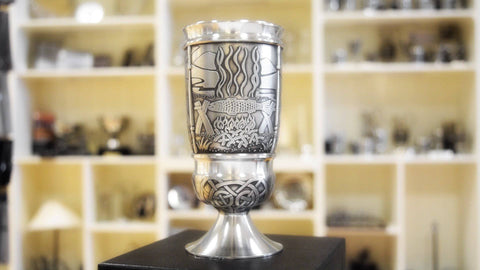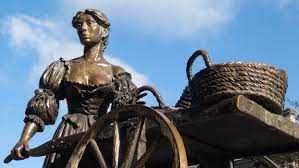Hey everyone, it's Aidan. This week I want to take a step backwards and talk about some of the most fascinating figures of Irish myths and legends. The Irish are a storytelling people and our legends and mythology are so rich that it's hard to choose just a handful of people to talk about. I've chosen four figures that have inspired and been immortalized in artworks by our gifted makers Rynhart and Mullingar Pewter. So sit back and let your imagination roam free as we get an overview on these legendary Irish folk.
Molly Malone
'Molly Malone' is one of the most well-known songs to come out of Ireland. It tells the story of a fishmonger who sold her wares on the streets of Dublin, and died young of a fever. The legend of Molly really started to coagulate in the late 20th century, and her image and reputation started to evolve. She began to be thought of as a misunderstood, socially outcast figure who sold cockels and mussels by day was a sex worker by night. Sometimes she has also been portrayed in the completely opposite light, being held up as an example of one of the few chaste female street street vendors of her day.
Despite much digging and much debate, it's been concluded that the woman herself wasn't actually a real person. The name "Molly" was a nickname for the names Mary and Margaret, meaning many, many, many Molly Malones have been born in Dublin over the centuries. Funnily enough, there is a record in the Irish annals of a Mary Malone who died on 13 June 1699. Because of this, the Dublin Millennium Commission have made June 13th "Molly Malone Day."
Here are the original lyrics of the song, and the story Molly's tragic life. During the 19th century, the expression "Dublin's fair city" was in regular use to refer to Dublin, and the phrase "alive, alive O" was often shouted by street vendors selling oysters, mussels, fish and so on.
In Dublin's fair city
Where the girls are so pretty
I first set my eyes on sweet Molly Malone
As she wheeled her wheelbarrow
Through streets broad and narrow
Crying, "Cockles and mussels, alive, alive, oh!"
Alive, alive, oh
Alive, alive, oh
Crying, "Cockles and mussels, alive, alive, oh"
She was a fishmonger
And sure 'twas no wonder
For so were her father and mother before
And they both wheeled their barrows
Through streets broad and narrow
Crying, "Cockles and mussels, alive, alive, oh
Alive, alive, oh
Alive, alive, oh
Crying, "Cockles and mussels, alive, alive, oh
She died of a fever
And no one could save her
And that was the end of sweet Molly Malone
But her ghost wheels her barrow
Through streets broad and narrow
Crying, "Cockles and mussels, alive, alive, oh
Alive, alive, oh
Alive, alive, oh
Crying, "Cockles and mussels, alive, alive, oh
Alive, alive, oh
Alive, alive, oh
Crying, "Cockles and mussels, alive, alive, oh
Grace O'Malley
Grace O'Malley's story is indeed a wild and fantastic one. She's most famous for being the enemy and thorn in the side of Queen Elizabeth I, as well as being a vengeful medieval pirate. For some reason no mention of her can be found in the Irish annals, so anything we know about her comes mostly from English sources. A major source is the English State Papers and in other similar documents that mention her specifically, so we know she really did exist.
Grace (also known as Gráinne Mhaol or Gráinne Ní Mháille) as born in Clew Bay, County Mayo, around 1530. Grace's family were very powerful, having many castles along the coast of Mayo and charging a tax to anyone who fished in the waters there. Carrickkildavnet Castle on Achill Island off the coast of Mayo is thought be one of the O'Malley family castles.
When her father died Grace took over the leadership of their territory, despite the fact she had a brother, Dónal an Phíopa Ó Máille. She married Dónal an Chogaidh (Donal "of the war") Ó Flaithbheartaigh, which brought her greater wealth and influence. She allegedly also now owned three galleys and a number of smaller boats and used them to participate in the piracy that was rampant in Ireland at the time. This is how the legend of the ‘pirate queen’ of Connacht was born.
In 1565, her husband Dónal was killed in an ambush while hunting. He was most likely killed due to a feud with another clan over land, which was commonplace in medieval Ireland. It's rumored that she began an affair with a shipwrecked sailor as her lover, but this was cut short when he was killed by the MacMahons of Ballyvoy. Grace took her revenge and attacked the MacMahon castle of Doona and killed her lover's killers, earning her the nickname "the Dark Lady of Doona."
Grace was in a constant struggle with the British governors and officials stationed in Ireland. In 1593 her sons and her half-brother Dónal were taken captive by the English governor of Connacht, Sir Richard Bingham. Grace sailed to England to petition for their release and made a request to Queen Elizabeth I at her court in Greenwich Palace. They came to an agreement: Elizabeth would remove Bingham from his position in Ireland, and Grace would stop supporting the Irish lords' rebellions and her piracy. Bingham was removed, but eventually reinstated. Several of Grace's other demands, including the return of the cattle and land that Bingham had stolen from her, remained unmet. Bingham continued to plague Grace, so she too broke her agreement and in 1594 troops were quartered on her lands.

Fionn mac Cumhaill
Fionn (often anglicized as Finn McCool) is a warrior hunter in Irish mythology, but also makes appearances in the mythologies of Scotland and the Isle of Man. His father was the leader of the Fianna, a group of wandering warriors that feature prominently in Irish mythology. He and his father hailed from Leinster (the eastern portion of the country), while his mother was the daughter of druids.
Fionn proved himself to be a brave and gifted warrior even as a young boy. At just ten years old, a young Fionn defeated Áillen, the fire-breathing man of the Tuatha Dé Danann (a race of mythological, supernatural beings). This fire-breather came to the old Irish capital of Tara every year on the festival of Samhain to wreak havoc and destruction, lulling the city's men to sleep with his music and burning down the city while they slept. Fionn volunteered to face the foe, and, armed with a special spear to ward off the sleep-inducing music, he did so. Fionn was made the leader of the Fianna after this incredible defeat.
By far the most famous story of Fionn is his meeting of the Salmon of Knowledge. The legend was that an ordinary salmon ate nine hazelnuts that had fallen into the Well of Wisdom (an Tobar Segais) from nine hazel trees that surrounded the well. This gave the salmon all of the world's knowledge, and if someone were to eat the salmon, they too would gain this knowledge. The first person to eat of its flesh would in turn gain this knowledge.
Fionn met the poet Finn Eces (or Finegas) by the river Boyne. He had spent the past seven years fishing for the salmon, and finally caaught it. He gave the fish to Fionn and told him to cook it for him, but by no means was he to eat any of it. Fionn cooked the salmon for him, but burned his thumb when turning it over. The boy sucked his thumb to soothe the pain — little did Fionn know, however, that the salmon's wisdom had been concentrated in the specific spot he'd burned his thumb on! When he brought the cooked fish to Finn Eces, he could see that Fionn's eyes shone with wisdom as they had not before. He let Fionn eat the fish, giving him the full knowledge contained within the salmon, and Fionn was able to draw upon this knowledge whenever he sucked his thumb.

Queen Maeve
Like Grace O'Malley, Queen Medb (modern Irish Maedhbh, anglicized as Maeve) is celebrated for her autonomy in a repressive patriarchal society. She is known for being sexually liberated and ruthless in attaining power. She is said to have been born and lived in the very early medieval period, between 50 BCE-50CE.
Her father Eochaid Feidlech was the High King of Ireland and arranged her marriage her to Conchobar mac Nessa, the King of Ulster (the northern counties of Ireland). This is apparently because he had killed Conchobar's father, the former High King Fachtna Fáthach, in battle. With Conchobar she had a son, Glaisne, but their marriage was bad and she left him. Eochaid deposed the then-king of Connacht (the counties in the west of Ireland), and installed Medb in his place.

Medb married again, and was adamant that she be equal to her husband in wealth. When she discovered that her husband was one bull richer than her, she decided to take the only bull that was equal to her husband's. Because of a divine curse on Ulstermen, there was no resistance to her invasion. Only a teenaged Cúchulainn, another famed hero of Irish folklore, managed to slow the advance. Nevertheless, Medb secured the bull.

Medb's tomb is on top of the Knocknarea Mountain in County Sligo, one of Sligo's biggest attractions (literally!).
So there you have it, some of Ireland's most famous figures. Irish myths, legends and cultural are an unending source of inspiration for our makers, which makes us proud to stock the wonderful works of Rynhart and Mullingar Pewter. Have a look at their other stunning works and be inspired by the stories of Ireland.

